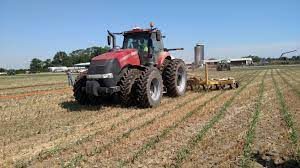Agronomy, Conservation, Homepage Slider, Water Quality
Is there a fit for in-season Liquid Manure Application for Soybeans?
By Dusty Sonnenberg, CCA, Ohio Field Leader: a project of the Ohio Soybean Council and soybean checkoff.

The use of livestock manure as a source of nutrients for crop production has been in place for decades. Manure is typically applied in the summer after wheat harvest, or in the spring prior to planting corn and soybeans, or in the fall after harvest. “The vast majority of liquid livestock manure in the Western Lake Erie watershed is surface applied in the fall without a growing crop. This results in most of the nitrogen being lost, and a portion of the phosphorus,” said Glen Arnold, Field Specialist for Manure Nutrient Management with The Ohio State University.
Over time, as the livestock industry has evolved, more livestock production systems are managing liquid manure versus solid manure. “Basically, we have built up a lot of liquid manure storage and application capacity and a lot of expensive equipment is used to move a lot of manure. The timing of manure application is getting to be a problem. There is a huge bottle-neck in the fall,” said Arnold. “With the loss of wheat acres in the state, more people are getting away from summer application and relying on fall application. The changing weather patterns and the increased rainfall events along fewer available acres have created a need to find alternatives, (acres to apply on and windows of opportunity to apply).”
Liquid manure has the physical properties that allow it to be managed in a way that it can applied in season to a growing crop. In the past manure was applied to soybeans as a surface application soon after the beans were planted, and just prior to emergence. This provided both moisture and nutrients for the soybeans to emerge and get a boost in early plant growth. As alternatives to apply manure to a growing crop have been explored, the practice of side-dressing corn with liquid manure has become more accepted. This has improved as equipment has been modified and designed to reduce crop damage. The switch from liquid tanker application to drag hose application has both reduced soil compaction and improved the application efficiency.
The questions that have emerged with these application changes have centered around the potential risk for crop injury/damage by the drag hose, and any resulting yield impacts. “Manure is currently being drag hose applied to corn up to the V4 growth stage,” said Arnold. Research has shown that any injury from the drag hose to the crop up to this stage does not negatively impact the yield.
It is assumed that manure cannot be applied to soybeans after emergence due to the risk of damage from equipment tracks and drag hose damage. Research, funded by the Ohio Soybean Council and Soybean Check-off is being conducted to explore the eventual application of livestock manure to emerged soybeans.
In research conducted by Arnold, manure was applied at three growth stages. Those include: V3. V5. And V7. The results showed that liquid manure can be drag hose applied to first crop soybeans, or double crop soybeans up to the V5 growth stage. There was not noticeable physical damage to the soybean plants until the V7 growth stage, and even then, it had little negative yield impact according to Arnold.
Manure applied to soybeans is typically not necessary from a nutrient standpoint, but it is an option for farmers to make an in-season manure application if there are storage capacity concerns at the hog farm. “This provides another window of opportunity for application,” said Arnold. “Soybeans like moisture, especially in dry years, and liquid manure is about 97% moisture. We would not expect a yield increase, year in and year out. The purpose of the research was to see if we could use soybean fields as an option if we needed a place to go with manure application in-season and not negatively impact the final yield due to injury from the drag hose. The soybean plant is pretty tolerant to the drag hose going over it up through the V5 growth stage.”
Arnold says that other benefits from the manure to soybeans include not only the nitrogen, but also the phosphorus, potassium and micro nutrients that manure contains.